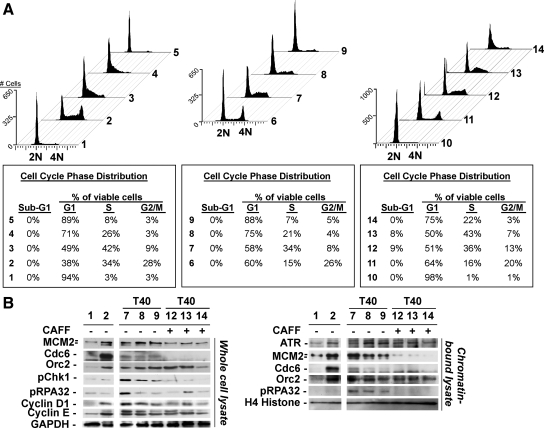Figure 3.
Cdc6 deficiency induces distinct G1-G1/S arrest and activation of ATR-dependent S phase checkpoint signaling required for S phase arrest in RPE1 cells. (A) G0 serum deprivation-synchronized RPE1 cells (1) were stimulated with 10% fetal bovine serum (FBS) and immediately transfected with 200 nM siLuc (2), 20 nM siCdc6 (3), 100 nM siCdc6 (4), or 200 nM siCdc6 (5). Twenty hours after transfection, cells were harvested and subjected to FACS. G0-synchronized RPE1 cells were stimulated with 10% FBS and transfected with 200 nM siLuc (6), 20 nM siCdc6 (7), 100 nM siCdc6 (8), or 200 nM siCdc6 (9). Forty hours after transfection, cells were harvested and subjected to FACS. G0-synchronized cells as in 1 or 6–9 were subjected either to additional 40 h of serum deprivation (10) or to additional 20 h of transfection + 2.5 mM caffeine (11–14) and were harvested and analyzed by FACS. Sub-G1 populations were calculated based upon all counts per sample; G1/S/G2/M populations were calculated from non–sub-G1 counts. As mentioned in Figure 1, G1 contains G1 and G1/S cells and G2/M contains late S and G2/M cells. (B) Whole-cell lysates (left) or chromatin-bound lysates (right) from the G0-synchronized RPE1 cells subjected to indicated conditions as described in A were immunoblotted with indicated antibodies. Note: Faster migrating band observed in anti-MCM2 blots comprises phosphorylated MCM2 species (Tsuji et al., 2006).

